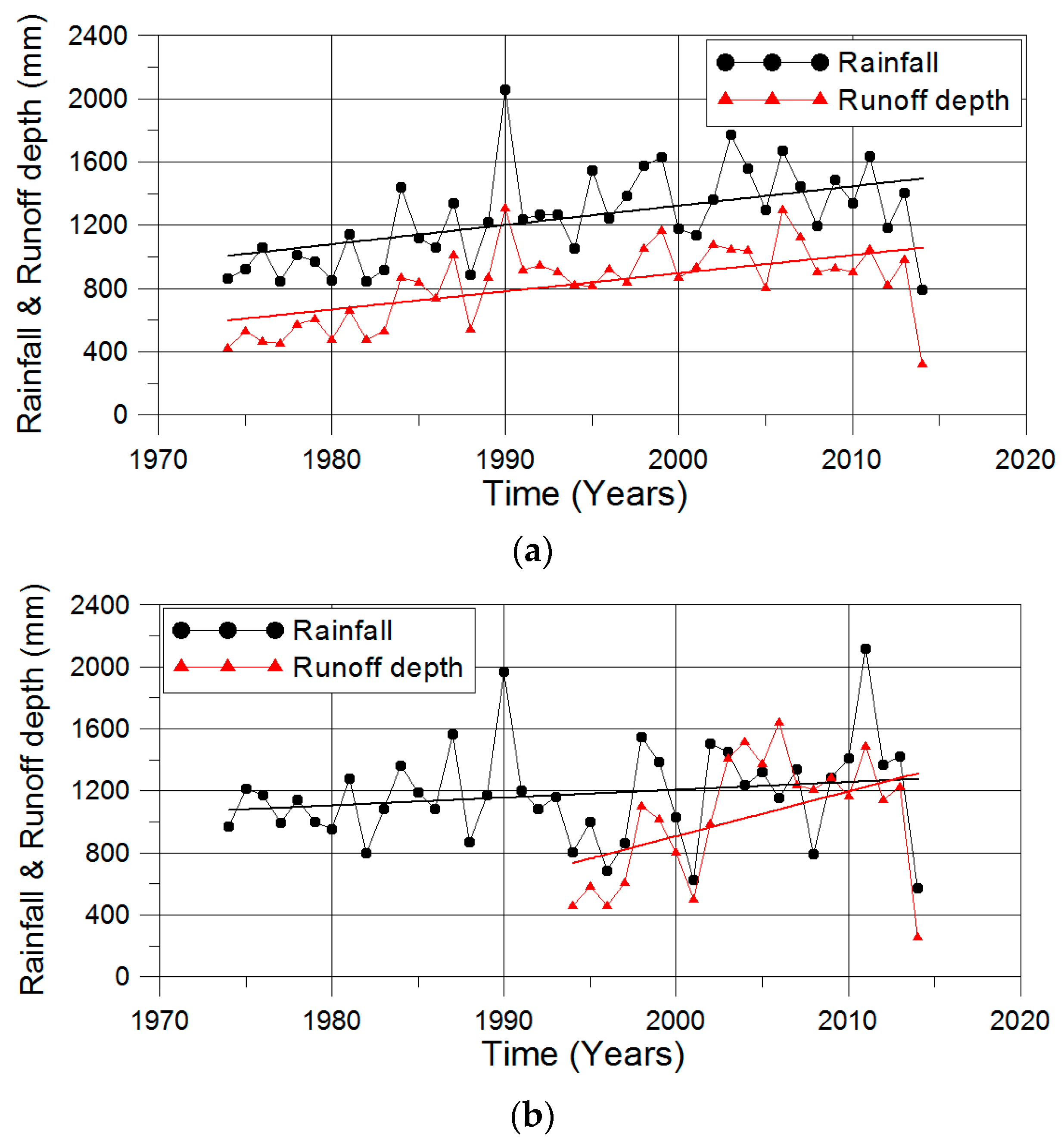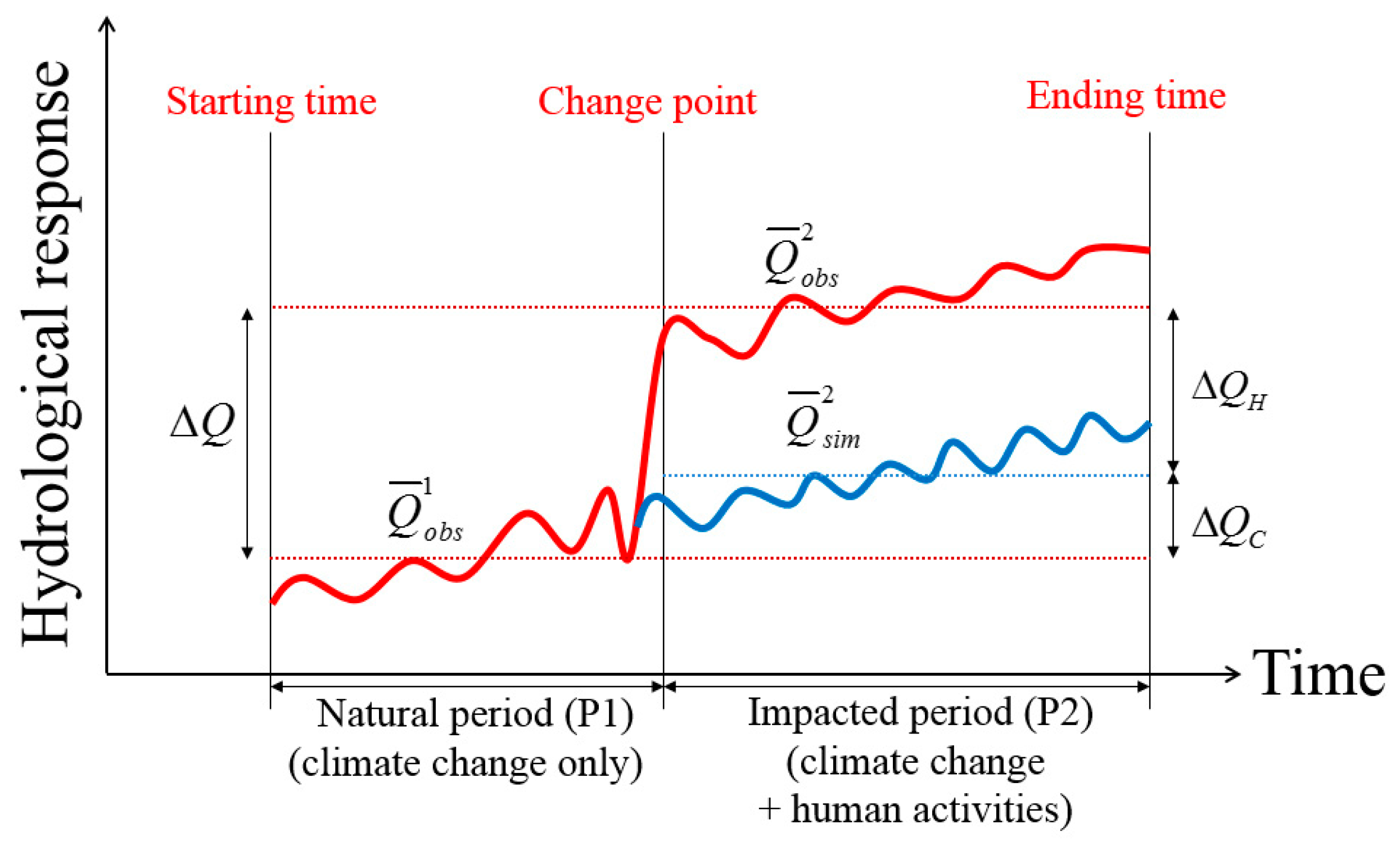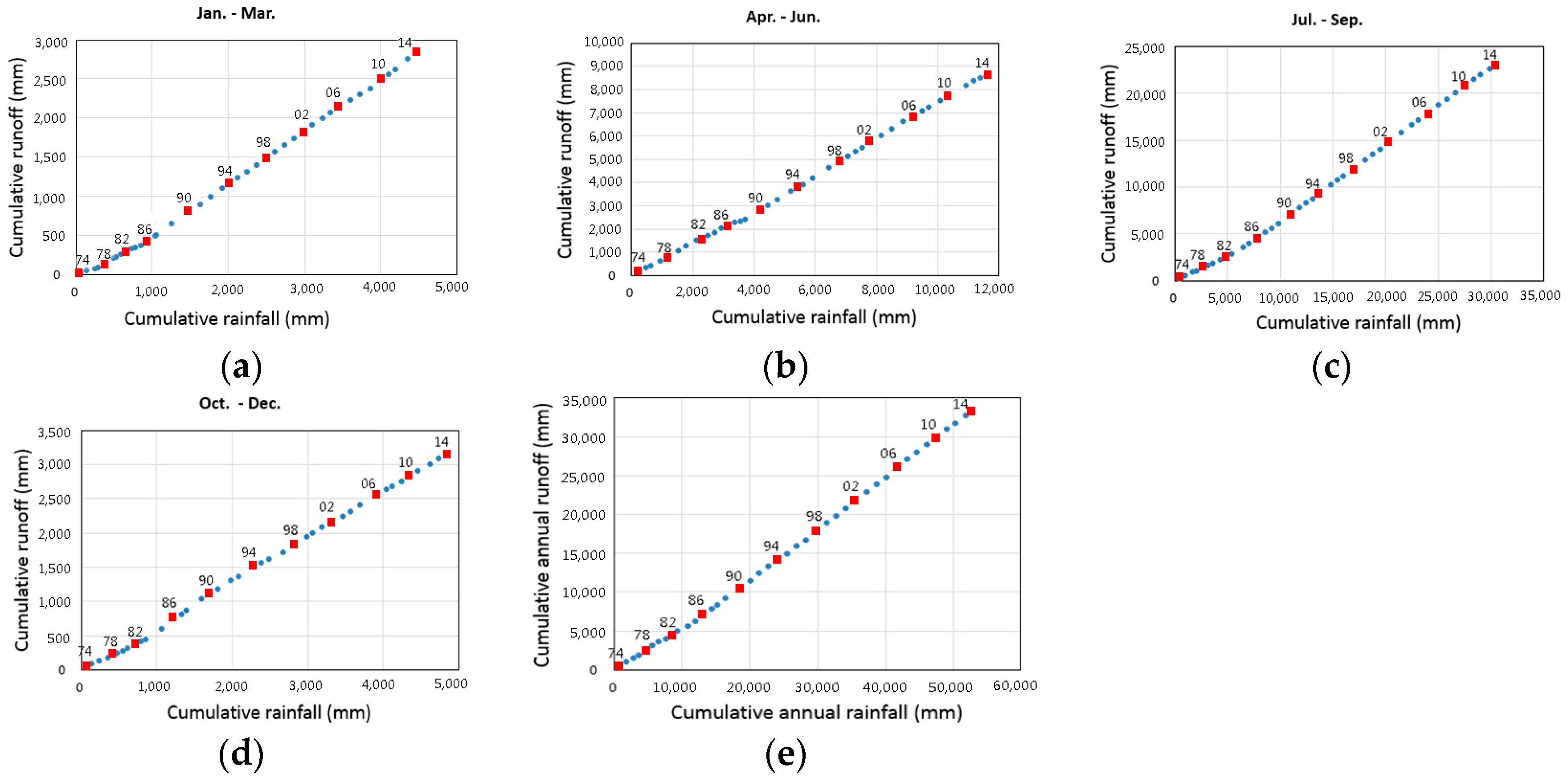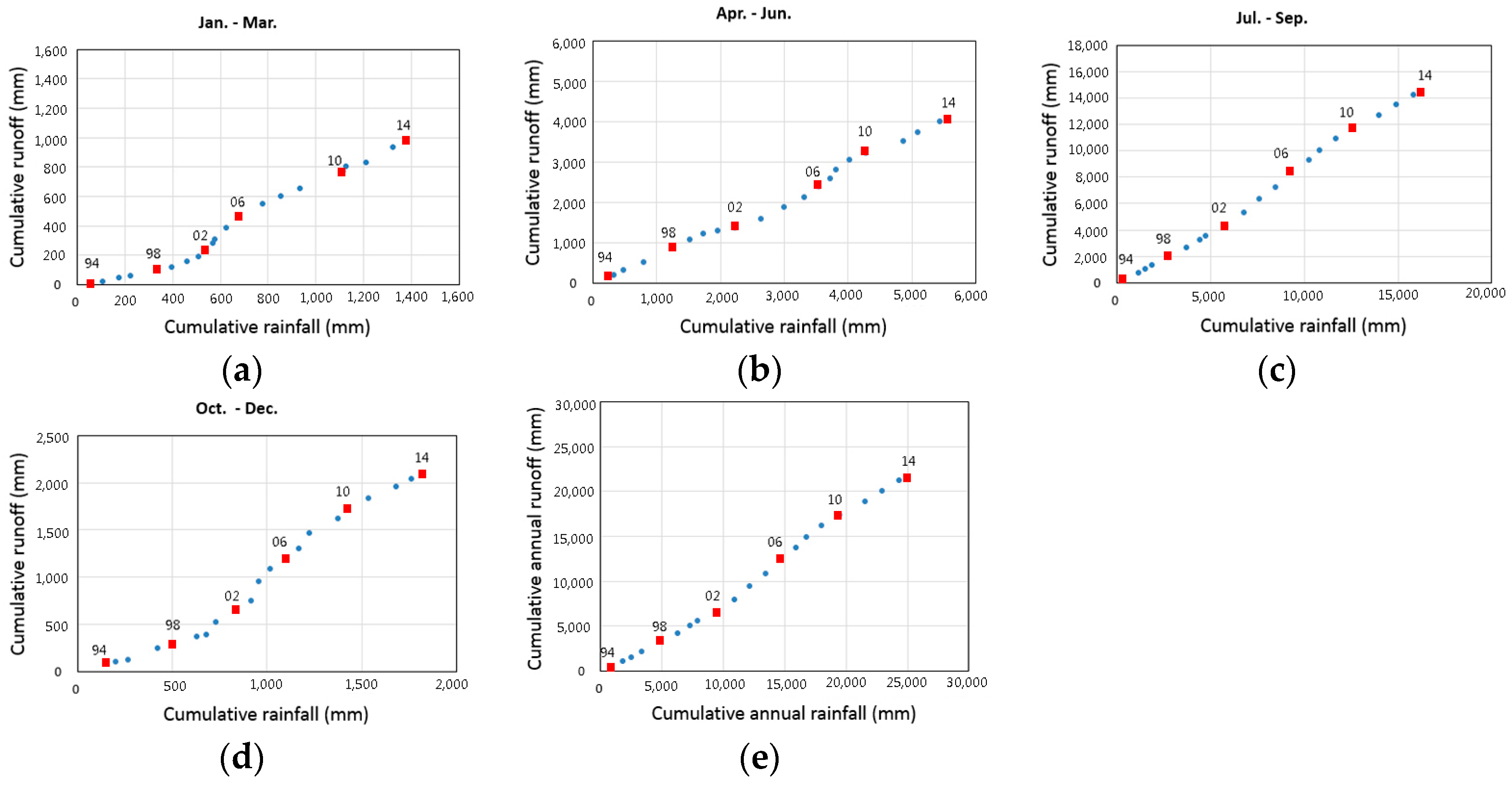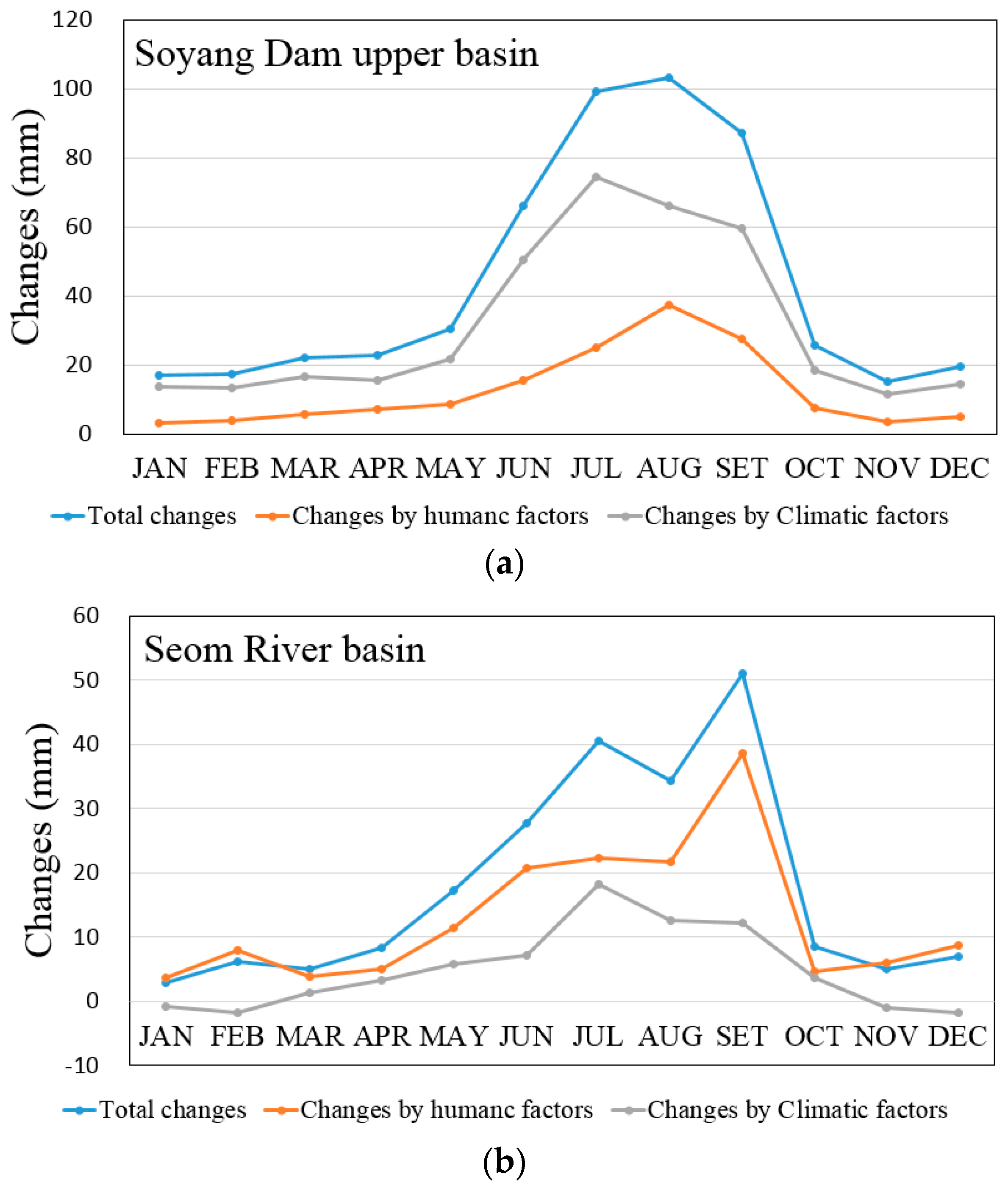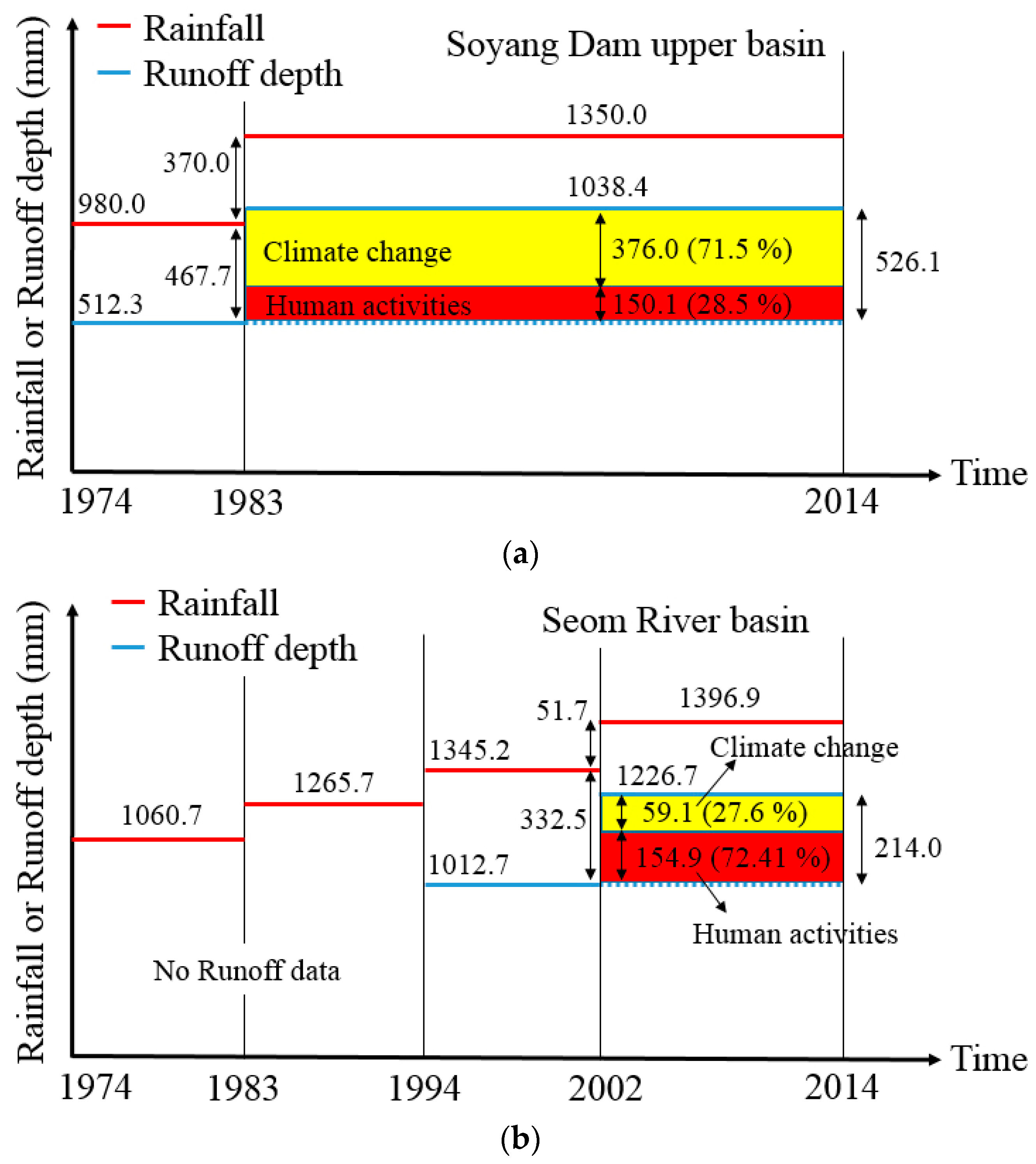1. Introduction
Variation of runoff in a water circulation system has a decisive effect on its components. In particular, gradual or abrupt changes in a water cycle can significantly impact various sub-systems, such as ecological systems in a basin. Hydrological responses, such as runoff, are affected by climate change and by human activities, including the construction of dams, land use change and water intake at a regional scale. Identifying the change in hydrological responses caused by climate change and human activities is crucial to the establishment of a reasonable water resources’ planning and management strategy in a specific watershed.
Most previous studies of the relationship between hydrological responses and these two types of factors have focused solely on the effect of meteorological variables on an annual time scale [
1,
2,
3,
4]. A number of studies related with runoff variability by global warming have been reported in the last two decades. These studies dealt with gradual and abrupt trends in precipitation, temperature and runoff, and they found that climate change by global warming was likely to increase the incidence of extreme events, causing more severe floods and droughts [
5,
6,
7,
8,
9]. Labat et al. [
10] found evidence for a 4% increase in global runoff with each 1 K increase in mean global temperature due to climate warming. Additionally, Milly et al. [
11] found changes in flooding patterns, with discharges exceeding 100-year levels from basins larger than 200,000 km
2, and they concluded that the frequency of floods had increased during the twentieth century. However, more efforts and scientific rigor are needed to attribute trends in flood time series [
12] because some studies suggested that the changes in flood behavior due to climate change were small and also did not show a clear increase in flood occurrence rate [
13,
14].
Meanwhile, human activities, such as deforestation, afforestation, construction of new dams and expansion of the impervious layer due to urban development, have changed the hydrological cycle in many watersheds. These human activities can increase or decrease the runoff in a basin. Tuteja et al. [
15] found that afforestation could reduce runoff by 16%–28% in southeast Australia. On the other hand, urbanization can significantly increase the area of impervious surfaces, which via the effect of sealed area abruptly alters hydrological responses on a regional scale. The increase in direct runoff volume and peak discharge due to increased impervious area later decreases infiltration and base runoff [
16,
17,
18]. Li et al. [
19] analyzed the reduction in runoff caused by afforestation. They suggested that more attention should be given to water resource availability and that the hydrologic consequences of re-vegetation should be taken into account in future management strategies.
Recently, water resource managers and planners have shown great interest in the relative impact of climate change and human activity on runoff variability at a catchment scale, because they are eagerly seeking to establish sustainable development strategies. An understanding of the relative impacts of climate change and human activities on hydrological responses should be integral to the creation of a water management plan [
20]. The quantitative separation of the impacts of climate change and human activities has therefore drawn attention [
21,
22,
23,
24,
25,
26,
27,
28,
29]. Particularly in South Korea, more attention has been paid to the identification of impacts from the two types of factors because of strong variation in regional precipitation and rapid urban development during the past few decades. However, the quantification of the separate effects of climate change and human activities on hydrological response is still challenging. More quantification of spatial impacts on a local scale and temporal impacts on various time scales is especially necessary.
Quantification of the relative impacts on runoff of the two types of factors can be performed in four ways: (1) investigation of experimental watersheds using paired catchment experiments; (2) application of physically-based hydrological models; (3) development of multiple regression models; and (4) analysis of water balance equations using hydrological sensitivity. Of these four approaches, the experimental watershed method may produce the most accurate results regarding water circulation and watershed characteristics, but the management of an experimental watershed costs much time and effort. The second approach, using hydrological models, can produce reasonable results, but may not accurately simulate the impacts of human activities on a catchment because of limitations in model performance and incorrect estimation of model parameters. Shrestha et al. [
30] suggested that the ability of the models to replicate different components of the hydrograph simultaneously was not clear. Especially quantification of streamflow characteristics using hydrological models in ungauged catchments remains a challenge [
31,
32]. In spite of its disadvantages, this approach is commonly used to simulate and calculate the relative impacts. Wang et al. [
25] used the two-parameter monthly hydrological model proposed by Xiong and Guo [
33] to estimate the impact of climate variability and human activities on the Haihe River basin in China. Jiang et al. [
22] used the distributed VIC-3L (Variable Infiltration Capacity-3Layer) model that has been successfully applied in China to reveal the relationship between the two types of factors. Additionally, Zeng et al. [
27] developed a SIMHYD physically-based model to investigate the factors impacting runoff in the Zhang River basin. Seyoum et al. [
20] ran a Soil and Water Assessment Tool (SWAT) semi-distributed model to identify the impacts of climate change and human activities on the Central Rift Valley lakes in East Africa. The third approach is to perform regression analysis to simulate runoff change in the absence of human activities. Huo et al. [
34] used an auto-regressive model and multi-regression to reconstruct streamflow data. Zhang and Lu [
35] employed a regression model to estimate the impacts by two factors in the Shiyang River basin. However, this approach may give misleading results if the determination coefficient of the developed regressive model is low. The last approach is to analyze water balance equations using hydrological sensitivity. This approach uses first order effects of changes in precipitation and potential evaporation on the basis of Budyko’s assumption, proposed by Budyko [
36]. The Budyko approach can be used to investigate long-term water balance at a large scale basin under the steady state. This approach can be used with various types of functions between precipitation and actual evaporation and efficiently captures changes in runoff due to climate change and human activities [
22,
24,
25,
26,
27].
In this study, therefore, the second and fourth approaches were used to quantitatively identify the impacts of the two types of factors. The main difference between the two selected approaches is the time scale. The hydrological model can simulate the daily runoff in a specific catchment. Climate change and human activities can therefore be quantitatively separated at monthly, seasonal, annual and other time scales. However, water balance equations should be developed using long-term time series because changes in water storage should be discounted reasonably. Therefore, the hydrological sensitivity method is only effective at the annual scale.
Many studies have identified only the impacts present at the annual scale, and some studies [
27] have been performed on monthly and seasonal scales. However, it is necessary to quantify and separate the impacts of the two types of factors over different time scales. Monthly and seasonal analyses are more significant than annual analysis in a watershed where temporal precipitation is unevenly distributed. In these cases, water resources should be allocated at the monthly or seasonal scale to manage seasonal droughts or floods.
South Korea in particular has had unprecedented torrential rainfalls since 1998, including rainfalls of 500 mm/day in the Imjin River basin and 870 mm/day in Gangneung Province. As the annual average rainfall for South Korea is about 1280 mm, the rainfall record of 870 mm/day was about 65% of the annual average. With regard to drought, the Korean peninsula faced a severe drought during 2014–2015. The total annual precipitation in these years was temporally less than 35%–50% of the long-term average from 1973 to 2015. As a result, the local government imposed water use restrictions in eight cities on the west coast of South Korea in 2015. The establishment of a monthly or seasonal water resources’ management strategy is therefore necessary in South Korea. Additionally, it is necessary to quantify the impacts of the two types of factors on hydrological responses in South Korea over different time scales. Hydrological modeling is therefore indispensable to the assessment of these impacts at higher time resolutions. In this study, the SWAT (Soil and Water Assessment Tool) model was used to investigate the effects of climate change and human activities on hydrological responses in two catchments at monthly, seasonal and annual time scales. In particular, the six hydrological sensitivity methods employed at an annual scale can be used to verify the results of the hydrological model-based approach.
2. Study Area and Data Characteristics
Two catchments undergoing a change in population and land use were selected to compare the relative impacts of climate change and human activities. One was the Soyang Dam upper basin (128°15′ E~128°56′ E, 38°13′ N~38°24′ N), located in northeastern South Korea (
Figure 1). Soyang Dam was constructed in 1973 and has played an important role in preventing floods and supplying water to the area around the Korean capital, Seoul. This basin is 2703 km
2 in area and consists of three sub-basins, Inbuk (923.8 km
2), Naerin (1069.3 km
2) and Soyang (709.9 km
2). The other catchment selected was the Seom River basin (128°02′ E~128°13′ E, 37°56′ N~37°89′ N), located about 150 km south of the Soyang Dam upper basin (
Figure 1). The area of this basin is 1491 km
2, and Hoengseong Dam, built in 2001, is located on the upper site. Hoengseong Dam is located at an elevation of 180.0 m and is 48.5 m in height and 205 m in length. This dam has 87 million m
3 of total storage, 119.5 million m
3/year of water supply capacity and 9.5 million m
3 of flood control capacity. The regulation of Soyang Dam to mitigate flood and drought cannot change hydrological responses in the Soyang Dam upper basin because the dam is located at the outlet of the basin, while the regulation of the Hoengseong Dam can significantly regulate streamflow at the outlet of its basin because it is located at the upper site of the basin. However, the regulation of the Hoengseong Dam might effectively impact short-term runoff change.
Meteorological and hydrological data were collected at the two basins to assess the effects of climate change (
www.wamis.go.kr). The precipitation datasets at the two basins were collected, but potential evapotranspiration datasets at the two basin were calculated by the Penman–Monteith method [
37,
38]. Therefore, the net radiation, mean daily temperature and wind speed datasets in the two basins also were collected to perform the Penman–Monteith method. In the Soyang Dam upper basin, data for total annual rainfall and inflow into the Soyang Dam during 1974–2014 were collected. In the Seom River basin, data for total annual rainfall during 1974–2014 and runoff at Munmak gauge station during 1994–2014 were collected. The data were collected from 1994 because the gauge station was installed in 1993. Meanwhile, the role of human activities was calculated from the change of population and increased impervious area due to urban development. Therefore, data for population growth during 1966–2011 and the area of the impervious layer during 1975–2011 were collected at the two catchments.
Figure 2 shows the total annual rainfall and runoff depth for the two catchments. The averages for rainfall over 41 years in the Soyang Dam upper basin and the Seom River basin were 1249.8 mm and 1175.4 mm, respectively. The black and red lines in
Figure 2 roughly show the trends in the collected data by linear regression. The trends in total annual rainfall at the two catchments were similar to each other, while the trend in the runoff depth (= runoff volume/basin area) in the Seom River basin is more severe than that in the Soyang River basin.
In this study, a Mann–Kendall test based on a statistical hypothesis test was performed to more closely investigate trends in collected annual rainfall. The Mann–Kendall test is a non-parametric test used to identify trends in time series. One benefit of this test is that the data need not conform to any particular probability distribution. When
and
in time series
are independent, the statistics
and signs can be defined as the following equations. The statistical hypothesis test is performed to find the
p-value using
and significance level,
.
Table 1 shows the results of the Mann–Kendall non-parametric test, at the 5% significance level, for total annual rainfall in the selected basins. In this table, all annual averages showed increasing trends. It can therefore be concluded that climate change was similar in the two basins.
However, the runoff depth in the Seom River basin was considerably higher than that in the Soyang Dam upper basin.
Figure 2b shows that runoff depth was about twice as high during 2003–2013 as it was before 2004. This abrupt change in runoff depth was caused by the increase of impervious area and the operation of the Hoengseong Dam, which was built in 2001. Especially the regulation of the Heonseong Dam might effectively impact short-term runoff change. It was also necessary to evaluate population change and change in impervious area.
Figure 3 shows the change in population and impervious area in the two basins.
Figure 3a shows that the population in the Soyang Dam upper basin decreased during 1966–2011, while the population in the Seom River basin increased significantly after 1995. Additionally, as
Figure 3b shows, the impervious area caused by urban development increased dramatically after 1990 in the Seom River basin, while the increase in the Soyang River basin was relatively small. We therefore predicted that the hydrological responses in the Seom River basin would be impacted significantly by human activities due to the construction of the Hoengseong Dam, population growth and the expansion of impervious area.
5. Conclusions
The hydrological variability caused by climate change and regional human activities should be quantitatively analyzed and managed because it affects all living things, including humans, in a basin. It is necessary that the relative impacts on the hydrological responses of climate change and human activities be separated and quantitatively understood in order to establish an appropriate water resources planning strategy. In particular, the impacts of the two types of factors should be evaluated over different time scales in watersheds where precipitation is unevenly distributed at the annual scale, as it is in South Korea, because water resources’ plans to manage flood and drought should be established at the monthly or seasonal scale. However, only a few studies analyzing the impacts of the two types of factors at various time scales have been conducted.
In this study, we employed two approaches (the hydrological model based method using the SWAT model and hydrological sensitivity-based methods using the six Budyko curve functions) to quantitatively assess the relative impacts of climate change and human activities at monthly, seasonal and annual time scales. Two basins, the Soyang Dam upper basin and the Seom River basin, were selected for comparison based on population growth and change in land use. Firstly, trend analyses using rainfall and runoff depth were performed using the Mann–Kendall nonparametric test. All annual averages for rainfall in the two basins showed a slight increasing trend, but the runoff depth in the Seom River basin showed a significant increasing trend. Furthermore, this study detected change points using the double mass curve, Pettitt’s test and the BCP analysis. For the hydrological model-based approach, the SWAT model should be calibrated and validated in the natural period. After calibration, the annual results obtained from the hydrological model method were validated using the results from the six hydrological sensitivity methods. The six Budyko functions developed by Schreiber, Ol’dekop, Pike, Budyko, Fu and Zhang were used to estimate the changes caused by climate change.
We concluded that the results obtained from the hydrological modeling approach at the different time scales were reasonably accurate for the two basins. The results obtained from the hydrological model method at the monthly, seasonal and annual time scales were therefore used to identify the causes of change in the two basins. In the Soyang Dam upper basin, the change in runoff caused by human activities is 28.5%, and that caused by climate change is 71.5%, at the annual scale. We also found that the proportion of change due to human activities for JAS was slightly higher than the average of the proportions for other seasons. Through monthly analysis, it can be shown that the proportions for AUG and SEP were slightly higher than for other months. In the Seom River basin, the change in runoff caused by human activities is 72.4%, and that caused by climate change is 27.6%. Additionally, the proportions of change caused by human activities for the winter seasons (JFM and OND) were significantly higher than for other seasons. In particular, the proportions of change caused by human activities for JAN, FEB, NOV and DEC were higher than 120%. Finally, our results suggest that the impacts of climate change have been stronger than those of human activities in the Soyang Dam upper basin, while the impacts of human activities have been stronger than those of climate change in the Seom River basin due to the increase of impervious area in the long-term aspect and regulation of the Hoengseong Dam in the short-term aspect.
In this study, we performed a quantitative assessment of the impacts of climate change and human activities on hydrological responses in two basins in South Korea. The causes of change identified in the two basins were significantly different. The procedure used in this study can be used as a reference for regional water resources planning and management on monthly and seasonal time scales. In the future, the uncertainty analysis in this procedure should be performed to establish more effective strategies for water resources’ management. The detailed analysis related to flood and low flow characteristics using water cycle components should be performed, and also, the independent assumption for two factors in this study should be revised to identify the interaction between climate change and human activities in future work.

